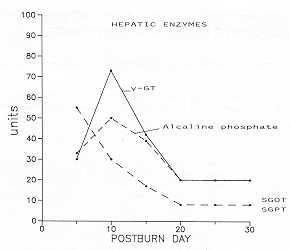Annals of the MBC - vol. 5 - n' 3 -
September 1992
THE
EVALUATION OF EARLY ENTERAL NUTRITION IN CHILD AND ADULT PATIENTS WITH EXTENSIVE BURNS:
OUR EXPERIENCE
Skodras K., Achilleos 0., Koulermoy G.,
Panayotoy P., Kastana 0., Vaos G., loannovich J.
Clinic for Plastic Surgery and
Microsurgery, General State Hospital & Second Department of Paediatric Surgery P. and
A. Kyriakou Children's Hospital, Athens, Greece
SUMMARY. The aim
of this study was to compare the effects of early enterat nutrition on extensive bums in
children and in adults. The nutrition substance (Reabilan) was administered undiluted by
nasogastric tube. The nitrogen balance, liver function, albumins and absolute lymphocyte
count were studied. In children, positive nitrogen balance was achieved earlier and the
absolute lymphocyte count was higher. Albumins remained at low levels longer in adults.
Hepatic enzymes reached maximum values earlier in children than in adults.
The extensive burn constitutes the maximal
injury stress to the human organism. It doubles or triples the basic metabolic
requirements and causes death in the immediate post-burn period.
The usd of enteral nutrition since the beginning of the 1970s, in the effort to reduce the
increased metabolic requirements, has led to an 80% diminution of morbidity, decreasing at
the same time the incidence of contamination of the burn wound and sepsis, which are the
main causes of the death of the extensive burn patient.
Recent experimental and clinical studies show that the early use of enteral nutrition
reduces the increase of the metabolic rate, diminishing the production of catabolic
hormones (cortisol, cdtecholamines, glucagon) and confronts the negative nitrogen balance
much earlier (MeArdle, 1984; Mochizuki, 1984; Liakakos et al., 1989; loannovich et al.,
1989).
Trials on experimental burn models show that sepsis is caused by bacterial translocation
through the intestinal mucosa to the blood stream. This translocation takes place because
of probable ischaemic anatomical and functional disturbances of the intestinal epithelium
that occur immediately after the burn (Mochizuki et al., 1984; Winchuck et al., 1982;
Maejuna et al., 1984; Coffy et al., 1988). The presence of food in the enteral tract
possibly protects the integrity and the function of the enteral epithelium, reducing
bacterial translocation, and thus protecting the burn patient from sepsis.
Aim of the study
The aim of this study is to compare the effects of early enteral nutrition on extensive
burns.
For this purpose two groups of burn patients were studied. The first group consisted of
patients in the Second Pediatric Surgery Department at the P. and Aglaia Kyriakou
Children's Hospital. This consisted of 18 children aged from 4 months to 13 years old (I I
boys and 7 girls), with bums in 15 to 60% BSA. The second group, from the Plastic Surgery
and Microsurgery Center of the General State Hospital, Athens, also consisted of 18
patients (10 men and 8 women) aged from 18 to 62 years, with bums ranging from 20 to 75%
BSA.
All patients were given enteral nutrition immediately after admission to hospital via a
fine-bore nasogastric tube. The catheter was placed through the nose and its position in
the stomach confirmed radiologically. Reabilan nutrition was used in this trial. This
consists of hydrolysed proteins (oligopeptids) 17.5%, carbohydrates 47.5% and lipids 35%
of total energy.
Reabilan was given undiluted, nitrogen balance, the time necessary positive initially and
the duration in remained positive, liver function with hepatic enzymes, the albumins and
lymphocyte count were studied.
Results
Table I
Nitrogen balance became positive in adults
in 4.2 days p.b. and in children in 2.6 days p.b. The ratio of the positive nitrogen
balance period to the duration of enteral nutrition was 87/113 in adults and 59/117 in
children.
Table II
The absolute lymphocyte number increased
gradually in adults from 1900 at 48 It p.b. to 3200 at the 20th day p.b. In children the
increase went from 3,040 at 48h p.b. to the final number of 4,370 at the 20th day p.b.
Table III
The serum albumin values were low in
adults until the second week p.b., with values, of 2.5 gr/100 ml, increasing to 3.6 gr/100
ml during the third week p.b. In children values varied within normal levels throughout
this trial (3.16 - 3.88 gr/100 ml).
Table IV
The hepatic enzyme values in Y-GT adults
were as follows: alkaline phosphatase and Y-GT progressively increased until the 15th day
p.b. when they reached the final maximum value. SGPT and SGOT progressively increased
until the 10th day p.b., slightly reduced until the 15th day p.b., and then followed a
reducing curve towards normal values.
In children alkaline phospatase and Y-GT reached their maximum value at the 10th day p.b.,
after which they reduced. SGPT and SGOT maximum values were reached at the 10th day p.b.,
after which they fell.
Conclusions
Positive nitrogen balance is achieved earlier in children. Albumins remain longer at low
levels in adults. Absolute lymphocyte count appears higher in children. Hepatic enzymes
reach maximum values in adults between the 10th and 15th post-burn day and in children
between the Ist and 10th post-burn day.
RESUME. Le but de cette
recherche est de confronter les eflets de la nutrition enterale precoce sur les brGlures
dtendues chez les enfants et les adultes. La substance Reabilan a etd administrde non
dilu& par tube nasogastrique. L'equilibre azotique, la fonction hepatique, les
albumines et le compte assolu lymphocytaire ont ete &udiés. Chez les enfants
I'equilibre azotique positif a ete realise plus precocement et le compte lymphocytaire
absolu &ait plus elevd. Chez les adultes les albumines sont restdes A des niveaux bas
plus longtemps. Les enzymes Mpatiques ont atteint les valeurs maxima plus prdcocement chez
les enfants que chez les adultes.
|


